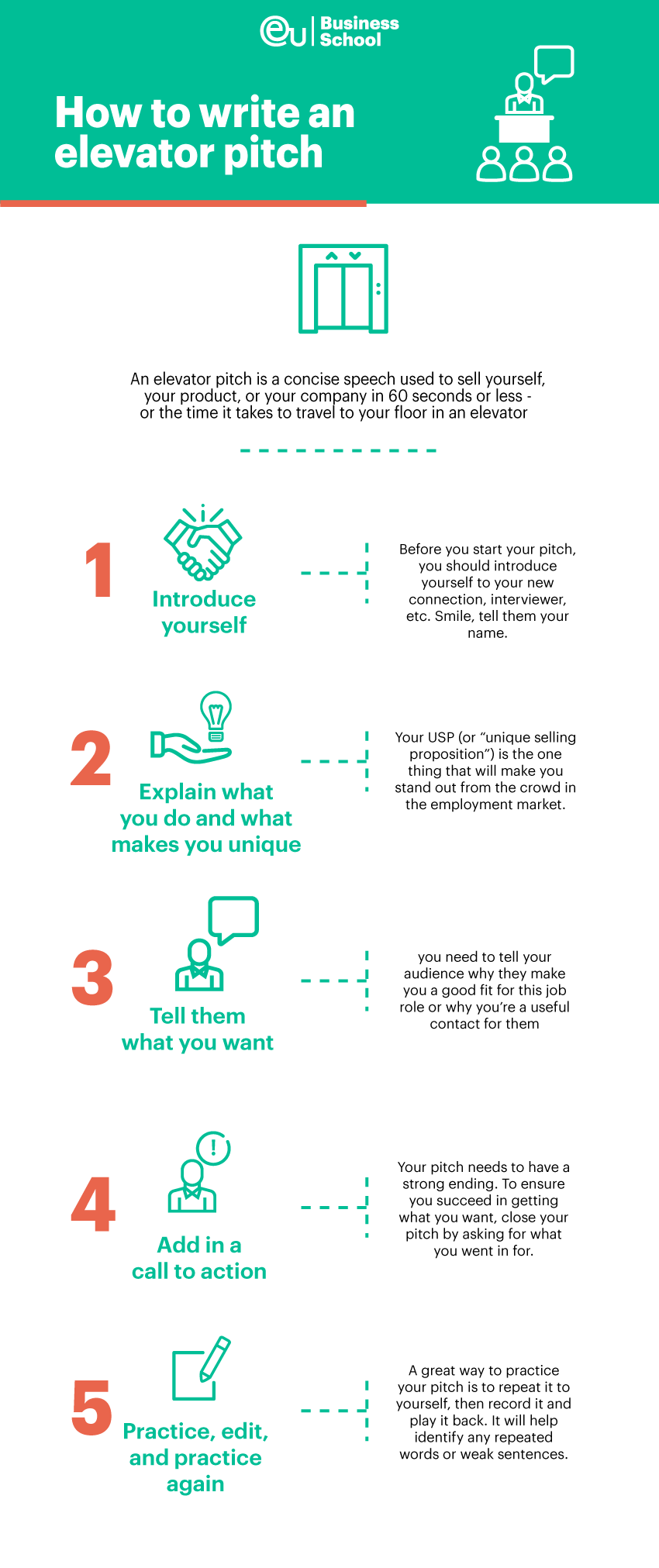30 Seconds to Impress: How to Write an Elevator Pitch
The ability to introduce yourself professionally and persuasively is the key to successful networking and job searching. One of the best tools for introducing yourself effectively in an interview or at a networking event is by giving a short “elevator pitch” to new contacts or prospective employers.
In this article, we will tell you what an elevator pitch is, how to write an elevator pitch, and share some examples of strong elevator pitches to help you write your own.
What is an elevator pitch?
An elevator pitch is a concise speech used to sell yourself, your product, or your company in 60 seconds or less – or the time it takes to travel to your floor in an elevator. Using this method to deliver a professional summary can be very effective in multiple settings, e.g., when you’re networking, job hunting, or even at a job interview. They need to be quick and compelling, and it’s very important not to rush!
Preparing one in advance, and practicing it in front of a mirror, will help you outline your skills and experience quickly and clearly in professional situations. You should also record it to see how much time it takes to deliver and whether any unnecessary words are taking up valuable seconds of a potential mentor or employer’s time.
Check out more tips on how to write an elevator pitch below.
How to write an elevator pitch
1. Introduce yourself.
Before you start your pitch, you should introduce yourself to your new connection, interviewer, etc. Smile, tell them your name, and in pre-COVID times, we’d always have suggested a handshake, too. It’s a good idea to add in a quick, “Nice to meet you,” or, “Thank you for your time,” as well, but don’t waste too many words on this. Remember: you’ve only got 30-60 seconds to impress them!
2. Explain what you do and what makes you unique.
Condense your background into two very punchy sentences. Of course, the more experience you have, the harder this will be. So, firstly, write down everything you can think of – education, career history, any outstanding achievements, etc. Then ask yourself, “What do I want this person to remember about me?” Those are the details that should make it into your pitch.
Your USP (or “unique selling proposition”) is the one thing that will make you stand out from the crowd in the employment market. Identify what sets you apart and tell people about it in the next section of your pitch.
3. Tell them what you want.
Once you have outlined your skills and your USP, you need to tell your audience why they make you a good fit for this job role or why you’re a useful contact for them. For example, if you can show you’ve had success in a similar, niche field, it will highlight the advantages of forming a professional connection with you.
4. Add in a call to action.
Your pitch needs to have a strong ending. To ensure you succeed in getting what you want, close your pitch by asking for what you went in for. Remember, this is your first contact with a prospective new contact or employer, so don’t overdo it. Anticipate, rather than demand, next steps.
Here are some examples of a call to action for the end of your elevator pitch, depending on what you might be seeking:
- Looking for a mentor: “Are you in a position to offer me mentorship?”
- Looking for a job: “Do you have time for a call next week to discuss upcoming opportunities on your team?”
- At a job interview: “Does that answer your question, or would you like further clarification?”
5. Practice, edit, and practice again.
As we have already mentioned, a great way to practice your pitch is to repeat it to yourself, then record it and play it back. Not only will this give you an idea of timing, which is very important—elevator pitches need to be short, or you won’t have time to get to the end!—it will also help identify any repeated words or weak sentences. You want the tone of your pitch to be confident but conversational, and not too sales-y.
When you are happy with your pitch, try it on a friend or family member and ask for their feedback. Check, do you sound natural, or were you going too fast? Is it representative of who you are? Does it flow well? etc.


Elevator pitch examples
Now that you know the basics of writing one, here are some examples of strong elevator pitches from the world’s most comprehensive search engine for jobs, Indeed. We have included three from different scenarios, so you have a template to follow, no matter what you are looking to achieve from your elevator pitch.
1. In an interview
“Hi, my name is Mark. Thanks so much for sitting down with me today. After graduating with my bachelor’s degree in Business Administration, I’ve spent the last three years building professional experience as an Executive Assistant. I’ve successfully managed end-to-end event coordination and have generated a strong professional network for my colleagues. I was excited to learn about this opportunity in the sports management space—I’ve always been passionate about the way sports bring cultures together and would love the opportunity to bring my project management and leadership abilities to this position.”
2. Seeking a mentor
“Hi, I’m Molly, so nice to meet you! I’m a Graphic Designer at ABC Inc., where I’m passionate about creating beautiful, intuitive designs for a variety of marketing collateral for our top-tier clients. Before that, I got my master’s in graphic design. I’m looking for experiences to learn more about career paths and ways to grow into assuming an Art Director role in the next few years. Your work with XYZ brand has inspired the ways I think about design—I would love to talk more about a potential mentorship with you if that’s something you have time for and would be interested in.”
Find out more about why mentoring matters and how you could benefit with this post from EU Business School.
3. Adding a contact
“Hello! My name is Anwar. It’s a pleasure to meet you. I have a background in Business Analytics with just over ten years of experience creating data-driven solutions for various business problems. Specifically, I love and have had great success in the strategic evaluation of data analysis with our executive staff. It sounds like you do similar work—I would love to keep in touch to learn more about what you and your company do.”













